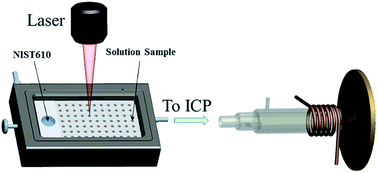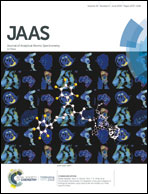Determination of major and trace elements in geological samples by laser ablation solution sampling-inductively coupled plasma mass spectrometry†
Abstract
To overcome the major shortcomings in conventional ICP-MS analysis with sample introduction by nebulization, a new solution sampling method was developed using laser ablation (LA). With this sampling method, water-related interferences were reduced by 1–2 orders of magnitude, the effects of which are similar to those obtained in membrane desolvation ICP-MS. Another important advantage of this method is that the matrix effects became insignificant in the ICP-MS analysis whether employing a matrix with the sample dilution factor varying between 80 and 2000 or an acid matrix ranging from 2% to 30% (v/v) HNO3. Compared with LA-ICP-MS analysis of solids, this sampling method exhibited 70–250 times improvement in signal sensitivity and the detection limits for most elements were two orders of magnitude lower. Unlike solid sample analysis, the commonly observed time-resolved element fractionation during laser ablation was negligible in solution sampling by LA. With the widely used reference material NIST 610 silicate glass as the external calibration standard and indium as the internal standard element, major and trace elements in a series of geological reference materials (ranging from mafic to felsic rocks) were successfully determined: the feasibility was verified with accuracies within 10% for 45 elements, and most of the precisions were reported as RSD better than 7%. Besides, due to the high tolerance of matrix effects, this method is comparatively green and environment friendly because of the minute consumption of acid and ultrapure water during the sample preparation process, which was reduced by 20–100 times compared to that in the conventional nebulization method. Being simple and effective, this method opens up a new prospect for the solution sampling of ICP-MS analysis.



 Please wait while we load your content...
Please wait while we load your content...